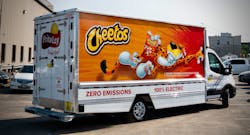NACFE releases early data from Run on Less - Electric DEPOT
The North American Council for Freight Efficiency (NACFE) and RMI launched Run on Less – Electric DEPOT (RoL-E DEPOT) on September 11 to understand the current state of electric trucking in North America. The organization will collect electric vehicle data until the end of September from 22 trucks operating out of 10 fleet depots and will release their initial findings in mid-October. NACFE will produce more detailed reports for release in the first half of 2024 but have already noted some points of interest surrounding electric vehicles (EVs), charging, and the industry’s progress with electrification.
“The data collection is going well,” said Mike Roeth, NACFE’s executive director. “We used this data along with work we completed prior to the Run to identify the current state of electric trucking and areas where we can expedite improvements to the known challenges.”
Read more: NACFE kicks off Run on Less–Electric DEPOTKey points fall into six broad categories:
- Small depots are ready for electrification now and electrification at large depots is becoming more possible.
- There have been big improvements in trucks and chargers since Run on Less – Electric in 2021.
- The industry needs cost and weight reductions to improve the total cost of ownership.
- Range can be extended with multiple charges per shift at the depot and en route.
- It’s still taking too long for power delivery and infrastructure to be installed, which is driving portable/temporary charging.
- The diversity, passion and capability of the people involved is helping to scale the adoption of electric trucks.
Roeth also reported that NACFE’s data collection for 2023’s RoL-E DEPOT can add greater depth and context to these key points. The event’s results are updated day-by-day on the its website and can be filtered by time, depot location, and vehicle, as well as the daily estimated energy usage, projected energy usage for a fully electric depot, and the cumulative electric miles between all participating depots.
From this data, NACFE has found that small depots in urban areas require smaller amounts of power, less investment, and less time to electrify, as evidenced by the following:
- Daily Purolator and UPS delivery routes are proving to be in the 14-42-mile range.
- Frito-Lay completely transformed its Queens location in about one year, needing only 0.9 MWh/day of electric energy.
- Fleets are charging many trucks with a few chargers, as evidenced by US Foods operating 15 heavy-duty tractors with only five portable chargers.
But it appears that larger depots have greater electrification capabilities as well.
“The electrification of large depots is more realistic than we originally thought,” Roeth commented, “and electric trucks are becoming an option in longer regional haul return-to-base operations.”
Larger fleets, along with their utilities and engineering, procurement, and construction partners, are delivering up to 5MWs to these depots as well as to charging-as-a-service sites, like WattEV. This is a necessity, as there is a significant amount of electricity needed for these large, heavy-duty trucks. But NACFE predicts that Scheider’s South El Monte depot would use 40.2 MWh/day if it were 100% electric, the highest daily energy demand the event has projected so far.
For data on range in larger fleets, the Tesla Semis at PepsiCo’s Sacramento beverages depot have completed 384 miles on a single charge and 806 miles in a single 24-hour day, enabled by fast 750 kW charging. But other Class 8 tractors are demonstrating range at double that of the trucks that took part in Run on Less – Electric in 2021 as well. The newer EVs are more efficient and their companies more aware of best practices to increase their vehicle range, including optimizing regenerative braking and return-to-base charging during single driver shifts. This has occurred consistently at OK Produce, Penske, Performance Team, PepsiCo, and Schneider.
Another challenge the industry faces with electrification is the length of time it takes to deploy infrastructure at depots and charging-as-a-service locations. NACFE conducted 122 interviews prior to the RoL-E DEPOT and said that interviewees reported that it takes from 12 to 36 months for infrastructure implementation. Part of the reason for this extended time frame is that long planning and approval cycles are necessary to enable the grid for these large loads, which also take too long.
Other electrification issues include supply chain challenges, planning inefficiencies, delayed permit approvals at the sites, and other problems. Fleets are employing temporary/portable chargers and other creative infrastructure solutions to avoid even longer delays so they can begin to use the trucks that have been delivered.
“Given all these opportunities and challenges, the NACFE/RMI team is very impressed with the diversity, capability, passion, and dedication to making this happen,” Roeth noted. “During our 122 interviews, 49% of the people we spoke with were women and people of color. These new faces are bringing fresh energy and creative solutions to trucking and are working to overcome obstacles in order to electrify depots.”
The Run is made possible through sponsorships with PepsiCo as an executive sponsor and Cummins and Shell as title sponsors as well as a host of companies that are event and supporter sponsors.

